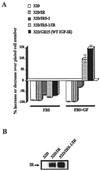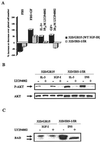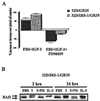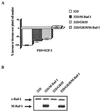Multiple signaling pathways of the insulin-like growth factor 1 receptor in protection from apoptosis
- PMID: 10490655
- PMCID: PMC84713
- DOI: 10.1128/MCB.19.10.7203
Multiple signaling pathways of the insulin-like growth factor 1 receptor in protection from apoptosis
Abstract
The type 1 insulin-like growth factor receptor (IGF-1R), activated by its ligands, protects several cell types from a variety of apoptotic injuries. The main signaling pathway for IGF-1R-mediated protection from apoptosis has been previously elucidated and rests on the activation of phosphatidylinositol 3-kinase, Akt/protein kinase B, and the phosphorylation and inactivation of BAD, a member of the Bcl-2 family of proteins. In 32D cells (a murine hemopoietic cell line devoid of insulin receptor substrate 1 [IRS-1]), the IGF-1R activates alternative pathways for protection from apoptosis induced by withdrawal of interleukin-3. One of these pathways leads to the activation of mitogen-activated protein kinase, while a third pathway results in the mitochondrial translocation of Raf and depends on the integrity of a group of serines in the C terminus of the receptor that are known to interact with 14.3.3 proteins. All three pathways, however, result in BAD phosphorylation. The presence of multiple antiapoptotic pathways may explain the remarkable efficacy of the IGF-1R in protecting cells from apoptosis.
Figures











Similar articles
-
Transient activation of Jun N-terminal kinases and protection from apoptosis by the insulin-like growth factor I receptor can be suppressed by dicumarol.J Biol Chem. 2001 Jun 1;276(22):19244-52. doi: 10.1074/jbc.M008186200. Epub 2001 Feb 21. J Biol Chem. 2001. PMID: 11278392
-
Activation of the insulin-like growth factor 1 signaling pathway by the antiapoptotic agents aurintricarboxylic acid and evans blue.Endocrinology. 2001 Jul;142(7):3098-107. doi: 10.1210/endo.142.7.8265. Endocrinology. 2001. PMID: 11416032
-
In cardiomyocyte hypoxia, insulin-like growth factor-I-induced antiapoptotic signaling requires phosphatidylinositol-3-OH-kinase-dependent and mitogen-activated protein kinase-dependent activation of the transcription factor cAMP response element-binding protein.Circulation. 2001 Oct 23;104(17):2088-94. doi: 10.1161/hc4201.097133. Circulation. 2001. PMID: 11673351
-
Insulin-like growth factor-I-dependent signal transduction pathways leading to the induction of cell growth and differentiation of human neuroblastoma cell line SH-SY5Y: the roles of MAP kinase pathway and PI 3-kinase pathway.Endocr J. 2000 Dec;47(6):739-51. doi: 10.1507/endocrj.47.739. Endocr J. 2000. PMID: 11228049
-
The IGF-1 Signaling Pathway in Viral Infections.Viruses. 2021 Jul 29;13(8):1488. doi: 10.3390/v13081488. Viruses. 2021. PMID: 34452353 Free PMC article. Review.
Cited by
-
Defective IGF2 and IGF1R protein production in embryonic pancreas precedes beta cell mass anomaly in the Goto-Kakizaki rat model of type 2 diabetes.Diabetologia. 2007 Jul;50(7):1463-71. doi: 10.1007/s00125-007-0676-2. Epub 2007 May 3. Diabetologia. 2007. PMID: 17476475
-
Controlled dimerization of insulin-like growth factor-1 and insulin receptors reveals shared and distinct activities of holo and hybrid receptors.J Biol Chem. 2018 Mar 9;293(10):3700-3709. doi: 10.1074/jbc.M117.789503. Epub 2018 Jan 12. J Biol Chem. 2018. PMID: 29330302 Free PMC article.
-
Recombinant production of growth factors for application in cell culture.iScience. 2022 Sep 3;25(10):105054. doi: 10.1016/j.isci.2022.105054. eCollection 2022 Oct 21. iScience. 2022. PMID: 36157583 Free PMC article.
-
Deficiency of insulin-like growth factor-1 receptor confers resistance to oxidative stress in C2C12 myoblasts.PLoS One. 2013 May 10;8(5):e63838. doi: 10.1371/journal.pone.0063838. Print 2013. PLoS One. 2013. PMID: 23675509 Free PMC article.
-
Identification of Aberrantly Expressed lncRNAs Involved in Orthodontic Force Using a Subpathway Strategy.Comput Math Methods Med. 2019 Sep 2;2019:9250129. doi: 10.1155/2019/9250129. eCollection 2019. Comput Math Methods Med. 2019. PMID: 31565070 Free PMC article.
References
-
- Avruch J. Insulin signal transduction through protein kinase cascades. Mol Cell Biochem. 1998;182:31–48. - PubMed
-
- Backer J M, Myers M G, Jr, Sun X J, Chi D J, Shoelson S E, Miralpeix M, White M F. Association of IRS-1 with insulin receptor and the phosphatidylinositol 3′-kinase. J Biol Chem. 1993;268:8204–8212. - PubMed
-
- Baserga R, Hongo A, Rubini M, Prisco M, Valentinis B. The IGF-I receptor in cell growth, transformation and apoptosis. Biochim Biophys Acta. 1997;1332:105–126. - PubMed
-
- Baserga R. The price of independence. Exp Cell Res. 1997;236:1–3. - PubMed
-
- Brunet A, Bonni A, Zigmond M J, Lin M Z, Jun P, Hu L S, Anderson M J, Arden K C, Blenis J, Greenberg M E. Akt promotes cell survival by phosphorylating and inhibiting a forkhead transcription factor. Cell. 1999;96:857–868. - PubMed
Publication types
MeSH terms
Substances
Grants and funding
LinkOut - more resources
Full Text Sources
Other Literature Sources
Research Materials
Miscellaneous
